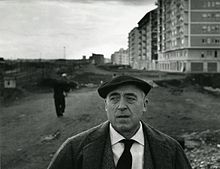Cesare Zavattini
Cesare Zavattini | |
|---|---|
 Cesare Zavattini (photo by Paolo Monti, 1975) | |
| Born | 20 September 1902 Luzzara, Italy |
| Died | 13 October 1989 (aged 87) Rome, Italy |
| Occupation | Screenwriter |
| Years active | 1936–1975 |
| Children | Arturo Zavattini |
Cesare Zavattini (20 September 1902 – 13 October 1989) was an Italian screenwriter and one of the first theorists and proponents of the Neorealist movement in Italian cinema.
Biography[edit]
Born in Luzzara near Reggio Emilia in northern Italy, on 20 September 1902, Zavattini studied law at the University of Parma, but devoted himself to writing. He started his career in Gazzetta di Parma.[1] In 1930 he relocated to Milan, and worked for the book and magazine publisher Angelo Rizzoli. After Rizzoli began producing films in 1934, Zavattini received his first screenplay and story credits in 1936. At the same time he was writing the plot for the comic strip Saturn against the Earth with Federico Pedrocchi (script) and Giovanni Scolari (art) for I tre porcellini (1936–1937)[2] and Topolino (1937–1946).[3]
In 1935, he met Vittorio De Sica, beginning a partnership that produced some twenty films, including such masterpieces of Italian neorealism as Sciuscià (1946), Ladri di biciclette (1948), Miracolo a Milano (1951), and Umberto D. (1952).
In 1952, Zavattini gave an interview to The Italian Film Magazine 2, republished in English as "Some Ideas on the Cinema". The thirteen points Zavattini outlined are widely regarded as his manifesto to Italian neorealism.
In his only experience in Hollywood, Zavattini wrote the screenplay for The Children of Sanchez (1978) based on Oscar Lewis's book of the same title, a classic study of a Mexican family. At the 11th Moscow International Film Festival in 1979, he was awarded the Honorable Prize for the contribution to cinema.[4] In 1983 he was a member of the jury at the 13th Moscow International Film Festival.[5]
Zavattini died in Rome on 13 October 1989.[6]
Directors[edit]
Among the many celebrated directors of Italian and international cinema Zavattini worked with in his more than 80 films are:
- Vittorio De Sica,
- Michelangelo Antonioni,
- Hall Bartlett,
- Alessandro Blasetti,
- Mauro Bolognini,
- Mario Camerini,
- René Clément,
- Federico Fellini,
- Pietro Germi,
- Alberto Lattuada,
- Mario Monicelli,
- Elio Petri,
- Dino Risi,
- Roberto Rossellini,
- Mario Soldati
- Paolo and Vittorio Taviani
- Luchino Visconti.
Also, In the short story "La Santa", by Nobel Prize winner Gabriel García Márquez a character is named after Zavattini. In the story, the character is a teacher of cinema.
Selected filmography[edit]
- I'll Give a Million (1936)
- The Dance of Time (1936)
- Saint John, the Beheaded (1940)
- A Woman Has Fallen (1941)
- Don Cesare di Bazan (1942)
- Before the Postman (1942)
- Fourth Page (1942)
- The Children Are Watching Us (1943)
- Piruetas Juveniles / Romanzo a passo di danza (1943)
- The Gates of Heaven (1945)
- Rome, Free City (1946)
- Un giorno nella vita (1946)
- The Testimony (1946)
- Sciuscià (1946)
- The Unknown Man of San Marino (1946)
- Crime News (1947)
- The Great Dawn (1947)
- Sperduti nel buio (1947)
- Ladri di biciclette (1948)
- Twenty Years (1949)
- Miracolo a Milano (1951)
- Mamma Mia, What an Impression! (1951)
- Umberto D. (1952)
- Ali Baba and the Forty Thieves (1954)
- L'oro di Napoli ("The Gold of Naples", 1954)
- La Ciociara ("Two Women", 1960)
- I sequestrati di Altona ("The Condemned of Altona", 1962)
- L'isola di Arturo ("Arturo's Island", 1962)
- Ieri, oggi e domani ("Yesterday, Today and Tomorrow", 1963)
- Un monde nouveau (1966)
- Caprice Italian Style (1968)
- I girasoli ("Sunflower", 1970)
- Il giardino dei Finzi-Contini ("The Garden of the Finzi-Continis", 1970)
- Una breve vacanza ("A Brief Vacation", 1973)
- Lo chiameremo Andrea (1975)
Bibliography[edit]
- Mino Argentieri, Neorealismo ecc. / Cesare Zavattini, Milano : Bompiani, 1979.
- Guglielmo Moneti, Lessico zavattiniano : parole e idee su cinema e dintorni, Venezia, Marsilio, 1992.
- Félix Monguilot Benzal, Piruetas juveniles: génesis, desarrollo y fortuna de la película olvidada de Cesare Zavattini en España, Actas del XIII Congreso de la AEHC, Vía Láctea Editorial, Perillo, 2011, pp. 381–390.
- Cesare Zavattini, Parliamo tanto di me, Milano, Bompiani, 1977.
- Cesare Zavattini, 'Some Ideas on the Cinema,' Sight and Sound 23:2 (October–December 1953),64-9. Edited from a recorded interview published in La revista del cinema italiano 2 (December 1952). Translated by Pier Luigi Lanza
References[edit]
- ^ Giorgio Bertellini (2007). "Cesare Zavattini (1902-1989)". In Gaetana Marrone; Paolo Puppa; Luca Somigli (eds.). Encyclopedia of Italian Literary Studies. Vol. 2. London; New York: Routledge. p. 2042. ISBN 9781579583903.
- ^ Horn, Maurice (1983). The World encyclopedia of comics. Vol. 5. Chelsea House. p. 599. ISBN 978-0-87754-323-7.
- ^ Barilli, Renato (1997). Le opere e i giorni di Cesare Zavattini. Dipinti (1938–1988). Bora. p. 172. ISBN 978-88-85345-57-7.
- ^ "11th Moscow International Film Festival (1979)". MIFF. Archived from the original on 3 April 2014. Retrieved 20 January 2013.
- ^ "13th Moscow International Film Festival (1983)". MIFF. Archived from the original on 7 November 2013. Retrieved 28 January 2013.
- ^ Ugo Pirro, Soltanto un nome nei titoli di testa, Einaudi, Turin, 1998, p. 30.
External links[edit]
- Cesare Zavattini at IMDb retrieved 15 October 2006
- Cesare Zavattini – Official website (in Italian), retrieved 15 October 2006
